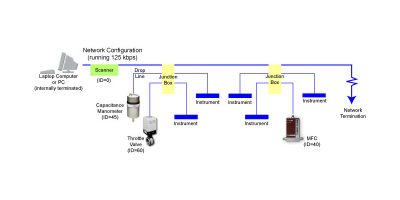DeviceNet™ Frequently Asked Questions
What is DeviceNet™
DeviceNet is based upon CANbus using the 11 bit identification standard. The 11 bit identification is broken down into 5 bits for the type (32 flavors) of messages and 6 bits for the MAC ID (64 addresses).
DeviceNet is a simple, networking solution that reduces the cost and time to wire and install industrial devices, while providing interchangeability of "like" components for multiple vendors.
DeviceNet is an Open Network Standard. The specification and protocol are open. Vendors are not required to purchase hardware, software or licensing rights to connect devices to a system. A DeviceNet Specification can be obtained from the Open DeviceNet Vendor Association Inc. (ODVA)
DeviceNet allows the interchangeability of simple devices while making interconnectivity of more complex devices possible.
The DeviceNet communication link is based on a broadcast-oriented, communications protocol; the Controller Area Network (CAN). In 1996, over 10 million CAN chips were produced. There are four main CAN chip suppliers; Intel, Motorola, Phillips and Hitachi.
DeviceNet has two primary purposes:
- Transport of control-oriented information associated with low-level devices
- Transport of other information which is indirectly related to the system being controlled, such as configuration
DeviceNet Characteristics
The list below is a summary of the Physical/Media specific characteristics of DeviceNet:
Bus type
CSMA/BA, master-to-slave, explicit and solicited messaging.
Unsolicited messaging, multiple masters, and peer-to-peer was introduced in early 1996 by the Systems SIG group of the ODVA for approval, conformance
review and implementation in 1996 and 1997.
Total number of nodes
64
Bus topology
Straight with restricted drops
Distance
500 meters full trunk line, 6 meter branches @ 125 kbps
250 meters full trunk line, 6 meter branches @ 250 kbps
100 meters full trunk line, 6 meter branches @ 500 kbps
156 meters accumlative distance
of the branches @ 125 kbps
78 meters accumlative distance of the branches @ 250 kbps
39 meters accumlative distance of the branches @ 500 kbps
Transmission media
Full trunk line - 2 wire twisted shielded cable with 2 wire bus power cable and drain wire.
Thin trunk line - same as full above but with lesser wire size which is more economical and easier to install.
Transmission signal
Square wave digital with NRZ (Non Return to Zero) encoding
Input bits per node
64 bits (allocated in bytes) standard in polling mode, larger fragmented messages are supported.
Output bits per node
64 bits (allocated in bytes) standard in polling mode 24 bits in explicit messaging. Fragmented messages are also supported.
Speed
125 kbps, 250 kbps, 500 kbps
Bus power
8 Amp full trunk line, 4 Amp thin line
Duplicate address detection
Yes, nodes announce address on start-up and all listen. If a duplicate address is heard, the duplicate node will not advance to run mode.
Attendance check per scan Yes, a list is programmed
in the interface and checked
Error detection
Yes, CRC
Error correction
Yes, nodes that detect errors signal the sender to repeat.
Address settling
Off line via hand held programmer or with a dedicated interface and host. On line via the interface master using a reserved newcomer default address that is changed to an application address. Dip/rotary
switches are optional.
Node parameter programming
Can be very extensive to include drive/rotational and instrument parameters
History
The early days of DeviceNet were essentially Allen-Bradley. In 1992, Allen-Bradley started to share information and invite not only strategic partners, but direct competitors to become DeviceNet members. DeviceNet
was released at the ICEE show in Chicago, March 1994. Then, a year later, Allen-Bradley turned DeviceNet over to ODVA, Open DeviceNet Vendors Association.
Summary:
DeviceNet has all the ingredients for success; available silicon, a strong, early sponsor (Allen-Bradley) to get it through development stage, network management software, and a strong vendors group (ODVA) to refine, promote and evolve the product.
Digital/DeviceNet Benefits
Increase design flexibility
- Provides unlimited I/O ports by providing the ability to cascade networks
- Offers instrument interoperatability and Plug & Play capabilities
Improved process data management
- Affords Peer-to-Peer or Master/Slave management
- Increased throughput and repeatability as a result of faster response to process dimensions
Contains imbedded diagnostics, in situ calibration and proactive event and alarm notification
In situ diagnostic can extend preventive maintenance intervals - Reduced installation costs
Simplified wiring translates to fewer potential fault points, less required documentation and reduces labor and space cost for wiring
References
MKS Instruments, Inc.
tel: 978-645-5500
www.mksinst.com/
Turck USA
tel: 612-553-7300
www.turck.com/
Dearborn Group Technology
tel: 248-488-2080
www.dgtech.com/
Allen-Bradley Company, Inc.
tel: 414-382-2000
www.ab.com/
ODVA
tel: 954-340-5412
www.odva.org

 Ultra-High Velocity
Ultra-High Velocity